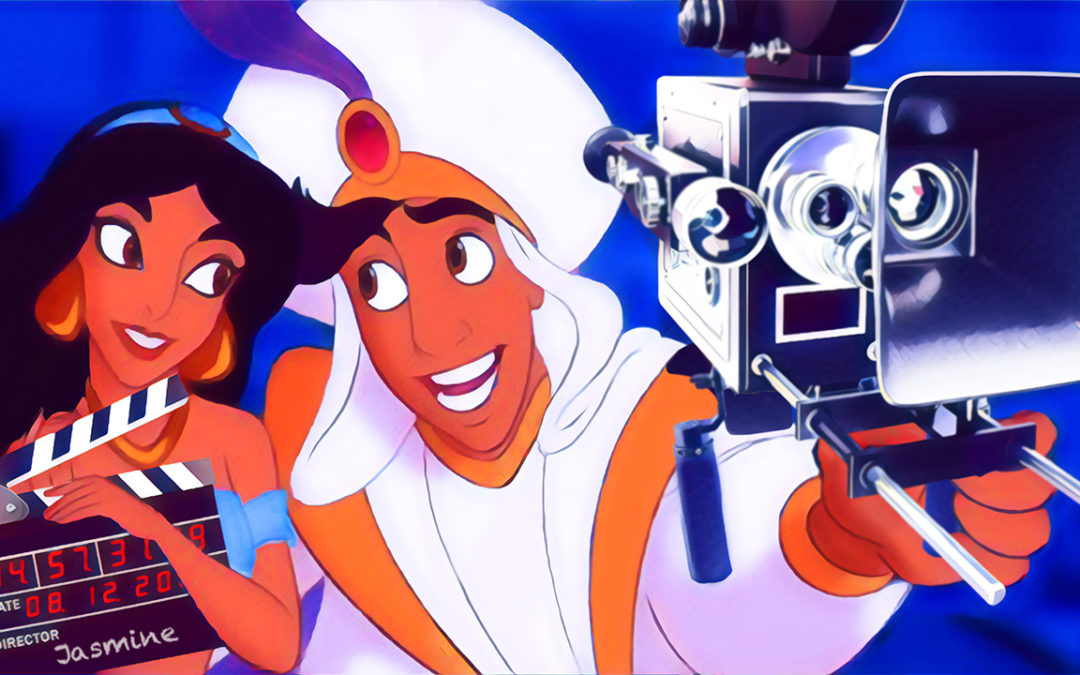The term “Renaissance” has been used by fans to describe the awakening and reinvention that brought public and critical interest to Disney Feature Animation in the 1990s, starting with The Little Mermaid (1989) and ending with Tarzan (1999).
But it wasn’t just the catchy music that garnered so much critical acclaim. From strong writing to creative editing, these animated films employ many of the cinematic techniques that previously were only seen in live action films.
So as a filmmaker, how can watching 90’s kid movies improve your craft? No matter which aspect of the filmmaking process interests you, you’ll find brilliant examples of it in these Renaissance Disney films.
To kick off this series, we’ll start with Aladdin (1992).
1. Don’t be afraid to scrap your story
…and start again. Things were going smoothly as directors Ron Clements and John Musker crafted the story of Aladdin and his single mother (yes, his mother!), based largely on the original tale. But then Beauty & the Beast was nominated for an Oscar. The stakes changed, and the first draft of Aladdin suddenly looked as if it wasn’t going to live up to its predecessor.

After a dreadful story reel screening for Disney chairman Jeffrey Katzenberg — a day that became known as “Black Friday” — the filmmakers were sent back to the drawing board. Only 19 months before Aladdin’s November 1992 release date, new writers Terry Rossio and Ted Elliot were recruited and a page one rewrite commenced.
Talk about tough breaks! But when Aladdin became the highest grossing film of 1992, and the first animated film to exceed $500k at the box office, it seemed like the right choice.
2. Use a proven screenwriting device
Aladdin follows a tried and true plot structure that is present in the likes of The Mask, Bruce Almighty, The Never Ending Story, and Bedazzled. A regular guy in tough times happens upon some kind of magic that seems to transform his life for the better — at first.

But the magical element gets out of hand, the lie is exposed, and our protagonist is once again at rock bottom. But this “darkest moment” is important for a solid character arc. Will the protagonist find his inner strength, without the need for magic?
Spoiler: yes he will! Aladdin discovers he doesn’t need to pretend to be someone else in order to earn the affection of others. Aladdin’s writers didn’t need to reinvent the wheel. They constructed an original and engaging tale filled with comedy and music around the skeleton of a common but effective storyline.
3. Pre-viz
The song-and-dance numbers are fun, colorful, and catchy — it’s basically impossible to get Prince Ali out of your head. (I know you’re singing it right now!) But an important element in pulling off these sequences is the elaborate, kitchen-sink visuals that accompany the great tunes. If you really think about the feat of animating complex sequences such as this, you may wonder where they even started.

Aladdin’s creative team employed an important process that is necessary for any live-action film — blocking. All animated films go through the storyboard phase, testing out different actions and movement for the characters, but Aladdin used dancers and choreographers to stage scenes while animators looked on. This is why the motion flows so well, and the timing is impeccable!
Whether your project is animated or live, pre-visualization (or “pre-viz”) is a must. Hire a storyboard artist. Block your actors. Film and edit a test shoot for particularly complicated sequences. This prep will save you headaches during production, and your characters will be more believable and realistic.
4. Research
Aladdin animators spent hours watching monkeys at the San Francisco Zoo to understand Abu’s movements. The animation style itself, with the swiftly drawn, curved lines, is based on the look of Arabic letters. Randy Cartwright, the animator in charge of Carpet, kept a small towel by his side at all times so he could understand how it would move if it came alive.

Nothing can take an audience out of it faster than seeing something unrealistic or implausible on screen. So do your homework. Even if your film is a fantasy (or otherwise not grounded in the real world), use every resource you have to create with authenticity and take your audience to a believable world.
5. Trust your actors
Aladdin opens with a prologue that features a vendor (voiced by Robin Williams), presenting various items in his shop. For this scene, Williams was presented with a box full of, well, stuff. He went through each item and improvised a lot of the dialog that ended up in the scene.

Throughout the film, he went off book to do what he does best — impressions! Which, of course, made their way into the animation, too. Some iconic moments came out of those spontaneous contributions. So, hire the best actor that you can, point them in the right direction, and trust them! You might end up getting something better than what’s on the page, but only if you approach the material with an open mind and a spirit of collaboration.

